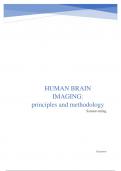Resume
Summary Human Brain Imaging: Methods for Research (B-KUL-P0T59A)
- Cours
- Human Brain Imaging
- Établissement
- Katholieke Universiteit Leuven (KU Leuven)
Notes from all the classes of Human Brain Imaging: Methods for Research (B-KUL-P0T59A)
[Montrer plus]



